Inserting into a concrete septic tank: how to waterproof with a plastic insert
The massiveness and external reliability of concrete rings attract homeowners. Concrete structures immersed in the ground easily resist soil pressure, they are not in danger of corrosion. Concrete stone is strong, waterproof and durable.
Septic tanks recruited from reinforced concrete rings are built quickly, but in 10-20 years they begin to flow ... Inserting a concrete septic tank or external sealing of the walls of a well will help to fix this problem. Which solution is better? Let's try to understand this material.
The content of the article:
Causes of leaking concrete septic tank
Monoblock and prefabricated structures made strictly from high-quality concrete - not lower than B-15, are used to build the well. Moreover, the brand for water resistance should be at least W8. Otherwise, the walls of the septic tank will pass water in both directions, regardless of the quality of the joints.
Errors in setting the rings lowered on the slings of the truck crane cause not only the curvature of the seam line between the precast elements. When assembling an underground tank from reinforced concrete rings the risk of them hitting one another is high.
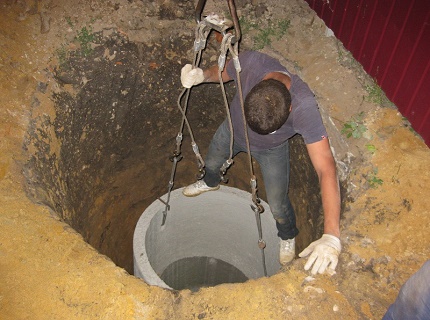
From the first time it is almost impossible to set the rings, you have to raise and lower them two or three times. Each reinforced concrete ring weighs about half a ton. Impacts of the upper prefabricated element on the lower segment do not pass without a trace - cracks and chips are formed.
Plowing is often underestimated by homeowners. As a result of heaving, the rings of the precast concrete tank are shifted.Through cracks in the septic tank, groundwater and flood water enter, significantly increasing the level of effluents in the treatment plant.
When a sewer structure is flooded, there is a high probability of untreated effluents coming out through unpressurized sections of the trunk. As a result, the surrounding soils and the waters that they contain will become infected.
A high level of groundwater is characteristic of the territories of the middle zone of the Russian Federation during floods. It is especially high (less than 500 mm) in areas removed from the wetland by land reclamation measures. It is almost impossible to achieve waterproofing the housing of a precast concrete septic tank in conditions of proximity to groundwater.
In case of insufficient or inefficient insulation of the upper part of the underground concrete tank, its outward protruding part will be destroyed in about 10 years. Critical defects will cause a change in the freezing and thawing cycles. Moisture penetrating into the pores of concrete freezes and expands, forming abundant microcracks. There is only one result - rain and flood water will enter the septic tank.

To eliminate leaks, waterproofing of the concrete septic tank is necessary outside or inside. The use of waterproofing compounds for repairing an operating reservoir is permissible only outside, since most waterproofing compounds are destroyed by contact with sewage.
The only solution for internal waterproofing is an insert into a concrete septic tank, which minimizes the amount of work inside the well. To give an idea of the nature of the work, then we consider both types.
Alternative to plastic insert
First empty the area to be repaired. storage tank or septic tank settling, having carried out the pumping out of the contents with the involvement of a team of sewage pumps. The service for pumping the septic tank, the removal of its contents is provided by utilities and private companies. It’s cheaper to negotiate directly with the municipal service provider.
Sewage vehicles will need a driveway to the work site. Moreover, the approach distance will be the smaller, the shorter the transport sleeve of the machine. Its permissible length is up to 180 meters and even more - up to 500 m, if it is a high-pressure polyethylene sleeve.
Pumping the septic tank must be performed by trained specialists, amateurs will not cope.Work on cleaning the septic tank is carried out by a special pump - sewer (fecal).
Waterproofing seams concrete septic tank
To close the gaps between the concrete rings of the well, you need to get to them outside the structure. It is necessary to dig a ditch around the septic tank to a depth that allows you to work with the joints between the reinforced concrete sections.
Accordingly, the more rings in the structure of the tank, the deeper the ditch will have to dig. The width of the ditch is not less than a meter. It will be difficult to work in a narrow ditch.
Having dug up the walls of the septic tank, you need to dry them. To the beginning waterproofing works there should be no dark spots on concrete walls. The seams must be cleaned from the accumulated debris and soil, exposing the cavity at least 70 mm deep.
If it is expected to rain, cover the well and the dug dug around it with a moisture-proof material (plastic wrap, tarpaulin, etc.).
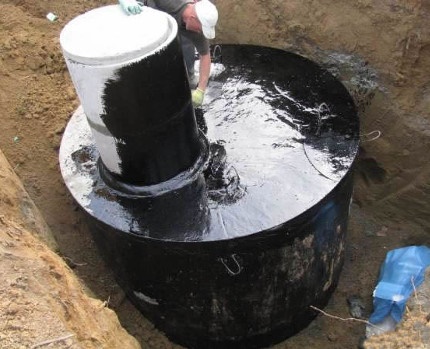
Well-washed clay and a stucco grater are required to fill the joints. Clay should be kneaded with legs in a basin or other similar container. Stuffing joints between concrete rings with unclean clay is ineffective - its structure is uneven, including voids that allow water to pass through.
The sealing of the external joints between the concrete sections of the septic tank can be done with a cement-sand mortar mixed with liquid glass. The composition of the mixture: water glass, cement and fine seeded sand in a ratio of 1: 1: 3.
The mixture should be prepared in small portions - when liquid glass is added, the solution solidifies quickly. The seams are filled with such a solution with a spatula.
The joint mortar is also prepared from a mixture of cement with PVA construction glue. Proportion: 5 parts of cement to 1 part of PVA. After filling the joints with a solution, two to three layers of water glass can be applied on top. This will enhance waterproofing.
Before filling the joints with cement mortar, it is necessary to treat them with a primer. For septic tanks, technical primers are used. For example, this is one part of bitumen into three parts of gasoline.
There are pores in the structure of concrete stone; therefore, septic tanks collected from reinforced concrete rings let water through, albeit in small quantities. When freezing, water in the pores will crystallize, increase in volume and eventually destroy the monolithic compound.
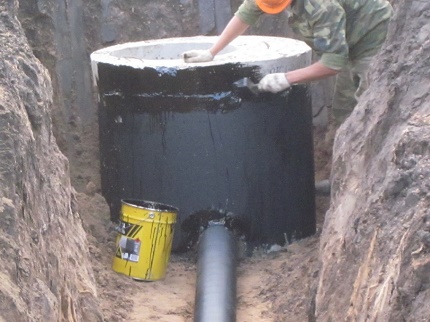
Installation of roll waterproofing
Having completed work on the seams of concrete rings, we proceed to the formation of a surface layer to protect the tank from moisture. If clay was used for joints, then roll materials cannot be applied over them - clay plaster will be broken when the adhesive mastic hardens.
The outer surface of the concrete well must be completely covered with a primer, for example, bitumen-gasoline. This will improve the bonding of the waterproofing roll with concrete rings. Then the walls are smeared with heated tar mastic, glued bitumen material in two or three layers is glued.
Note that bitumen mastic for waterproofing septic tank walls with roll materials is not suitable - when it cools, it cracks.
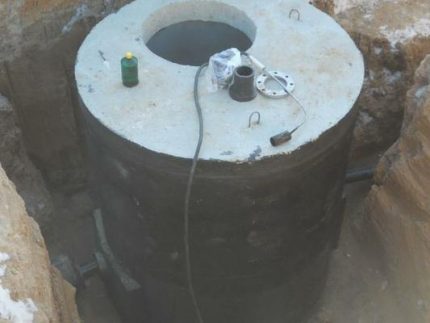
To reduce or eliminate the likelihood of soil heaving around the concrete shaft, sand and gravel backfill is used (40% sand, 60% gravel). It fills the ditch, previously dug around the underground tank for repairing the seams between the well rings.
If sand without clay inclusions, gravel or crushed stone deposits lies under the soil layer on the site, then backfilling can be carried out with the soil of the dump formed during the excavation of the foundation pit around the septic tank.
Plastic insert for septic tank waterproofing
Regardless of the depth of the well and the fame or the unknown of the leakage zones, a plastic cylinder inserted into a septic tank is capable of closing them all at once. To start the installation of the insert, it is necessary to empty the sewer tank by calling the sewer. Then you need to flush the walls and bottom of the well with a stream of water from a hose supplied under pressure.
Manufacturers of modular rings and full tanks made of plastic produce them ready-made, of various diameters and wall heights. It is possible to order non-standard containers and rings if the diameter of the repaired septic tank does not match the parameters of serial plastic rings (too large or small). It is optimal if there is a gap of 50-100 mm between the walls of the insert and the septic tank, not more.
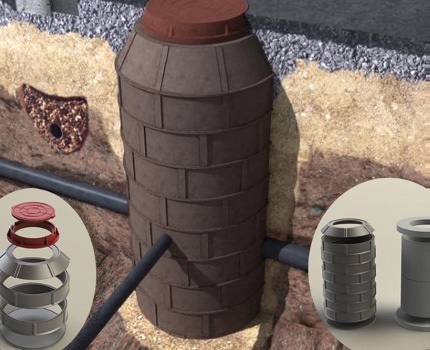
To restore the tightness of the concrete septic tank, plastic rings with 5 mm wall thickness are required. There is no need for thicker walls - the main concrete walls of the old well will provide ideal protection. Reinforcement ribs made around the perimeter of the plastic rings will retain the rigidity of the well insert when sewage flows.
Modular rings are connected to each other by a groove insert, welding or screwing. The weight of one section of the plastic insert (height 1500 mm, outer diameter 950 mm) is about 25-30 kg. To assemble the insert correctly, you must assemble its modules outside the well. A fully assembled insert is inserted into the septic tank manually (if the length is not more than three meters) or with a truck crane.
Mounting the prefabricated insert
When assembling the plastic composite sections of the rings, a standard rubber seal is placed in the lower ring tray, and the upper section is set. To combine the lower and upper ring of the insert, you need to put the board across and in the center, then click on it from both sides.
An important detail: the connected segments of the insert must be placed horizontally before pressing the board. Otherwise, the full entry of the upper section mounts into the lower tray cannot be achieved.
The ring modules, which are assembled by screwing, are combined into an insert of the required height inside or outside the well. The first option is suitable if the septic tank is not deep. Although it is more convenient to screw sections on the site, and then lower the assembled insert into the sewer tank.
Regardless of the method of combining plastic rings, the groove between them is additionally processed with silicone mastic. It is applied from two sides - external and internal. Of course, over the years of operation of the septic tank, the grooves in the insert will independently fill with sludge and will only increase their waterproofing properties.
However, in the first months and years of operation of the repaired septic tank, siltation will occur slowly. Therefore, the use of silicone for joints between sections is a necessary solution.
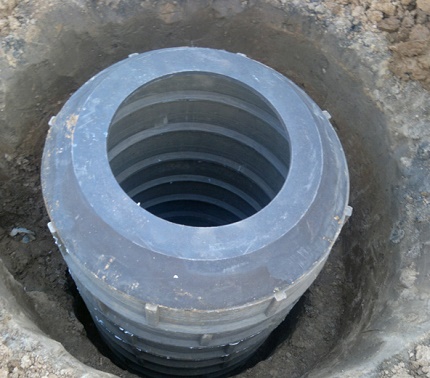
The lower module is the base of the entire insert; it is necessary to seal the septic tank. Before installing it in a concrete well (or exposing the fully assembled tank), make sure the septic tank bottom is strong. The required concrete thickness at the bottom of the sewer well is 150 mm.
When lowering the assembled plastic insert into the concrete tank, its significant deflection must not be allowed - the module mountings may be broken. Installation in the well of an insert with a number of modules of more than three is most correctly performed by suspension on slings of a truck crane.
Judge for yourself: the approximate length of the three-section well insert is 4.5 m; weight - about 100 kg. It is difficult to lower the plastic structure of such a length and weight into the septic tank.
The final stage of the assembly of the modular structure
If the protrusions of the pipes in the repaired septic tank are too long and will interfere with the installation of the plastic insert, they must be cut off. The inlet of the drain pipes into the cavity of the insert through its walls is made through sealing cuffs and rings, with the joints treated with silicone.
In plastic rings-modules of some manufacturers sectors (trays) for input are indicated sewer pipes. Regardless of whether there are such designations or not, to insert a pipe, it is necessary to cut a hole in a certain section using a jigsaw file.

There is a gap between the walls of the plastic tank and the old concrete septic tank - it needs to be filled. A cement-sand mixture is made in a ratio of 1: 5. Her backfill in the wall is dry.
Approximately from the middle of the depth of the tank, it is necessary to begin lightly tamping the cement-sand filling using a long wooden pole. The pole must be kept strictly horizontal so as not to touch the walls of the plastic well.
To be sure that the insertion channel does not shift during the filling and tamping process, you can fill it with water - first no more than a third of the capacity. As the gap between the walls of the septic tank is filled, water must be added to the well. It should be infused so that the level is 200 mm higher than the current level of dumping.
Installation of a plastic headband
The top section of the plastic insert for the septic tank is called the neck. In principle, its installation on a restored sewer well in a private courtyard is not required. But only if the flat ring of the concrete headband from the old septic tank is not damaged - there are no cracks or crumbled sections exposing the reinforcement.
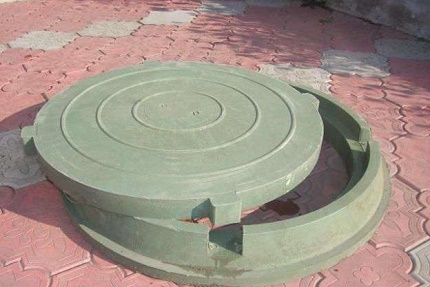
If there is no need for mounting the neck, then the upper edge of the plastic well insert needs to be withdrawn 120 mm above the ground, no more. The height of the reinforced concrete slab manufactured for the headband of the well according to GOST is 200 mm.
The upper edge of the plastic insert should not protrude beyond it. It is necessary to lay in the gap between the outer edges of the insert and the upper concrete slab a sealant - a cable (tarred wire).
The installation of the neck module allows you to do without laying a concrete ring-headband. On a plot of a private house, this is permissible if the septic tank is not under a pedestrian walkway or car area. It will be enough to close the neck plastic hatch the manufacturer that produced this set of modules for repairing a well.
Classic plastic waterproofing
If it is possible to install a monolithic cylindrical insert made of polyethylene in the trunk of a sewer well, then it is better to use this method. Work on the waterproofing device will be carried out much faster and with the lowest labor costs.
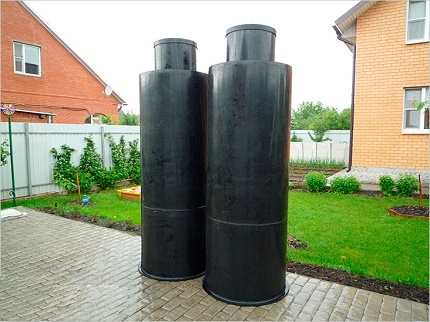
In the manufacture of inserts of this type, polyethylene is used - a material that is absolutely immune to direct exposure to aggressive media. The wall thickness of the case is 8 mm, which eliminates accidental structural damage during transportation and installation.
Before immersion of the insert into the barrel of a concrete septic tank, holes are drilled exactly in the outline of the connected communication lines to enter and exit the sewer pipes in the walls of the housing. Passages are sealed or scalded around the perimeter. The gap between the insert and the concrete walls of the septic tank is filled with concrete.
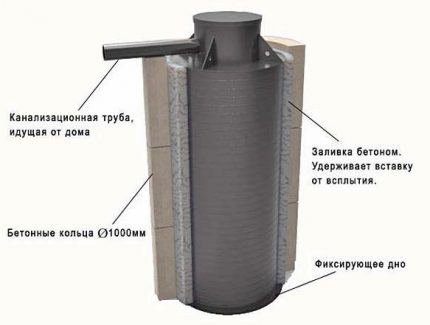
The choice of waterproofing method
Classical solutions for isolation from leaks from a sewer well constructed of concrete rings are quite effective. However, sealing joints, processing the walls of the tank with bituminous mastic and similar measures are only suitable for septic tanks under construction. Those. for new underground tanks not yet put into operation.
Unilateral waterproofing of the external walls, acceptable for septic tanks with many years of work, will reduce the degree of seepage of sewage into the ground. The durability of waterproofing coatings on the outer walls of a concrete well will remain for more than 10 years, but only subject to professional repair work and the use of high-quality materials.
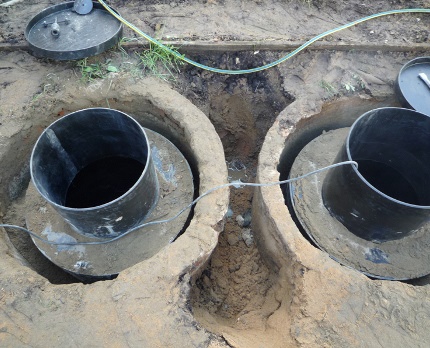
Plastic ring modules are produced at the enterprise, i.e. in the workshop. They are designed specifically for the repair of wells, the construction of new buried tanks. The plastic insert placed in a concrete well is not connected with its design.
Therefore, its tightness does not depend on the degree of wear of the repaired septic tank, it will only be a protective case for a plastic tank.
Own performance of a plastic container designed for waterproofing a septic tank is quite high:
- low weight (in comparison with reinforced concrete);
- complete tightness;
- low thermal conductivity;
- resistance to abrasion, to aggressive environments;
- long service (more than 40 years);
- high impact strength, resistance to mechanical stress;
- immunity to ultraviolet;
- frost resistance;
- simple installation (except for the welded principle of section assembly).
Therefore, the choice in favor of a polyethylene insert is most justified. Getting rid of problems with a leaking sewer well in a suburban area for decades is a great option! We also recommend reading our other article on waterproofing methods concrete septic tanks.
Conclusions and useful video on the topic
In this video, plastic modules can be viewed from all sides and even touch:
Video about the assembly of the well from plastic elements at the installation site:
A well insert made of plastic will completely solve three problems: leaks through joints, through cracks and through walls of concrete rings. However, the price of such repairs will not be cheap. The cost of a 1.5 meter insert segment with a diameter of 950 mm and 5 mm wall thickness is approximately 15,000 rubles. However, decades without sewer “surprises” are worth it.
Are you going to install a plastic insert in a concrete septic tank, but do not know where to start? Or is there experience in carrying out such work? Please share your knowledge with our readers - leave comments in the block below.

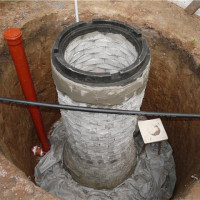 How and what is the waterproofing of sewer wells
How and what is the waterproofing of sewer wells 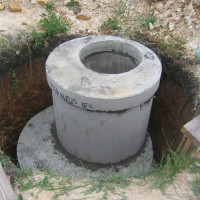 How to make a sewer well: do-it-yourself installation and installation
How to make a sewer well: do-it-yourself installation and installation 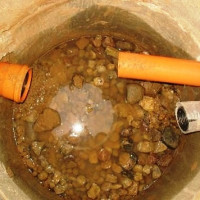 Filter well: design, purpose, device technology
Filter well: design, purpose, device technology 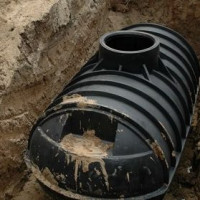 Sewerage in a private house: an overview of the options for arrangement + a step-by-step guide
Sewerage in a private house: an overview of the options for arrangement + a step-by-step guide 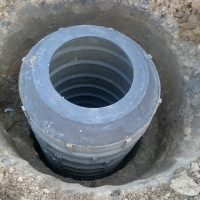 Polymer-sand wells: device, advantages and disadvantages, installation rules
Polymer-sand wells: device, advantages and disadvantages, installation rules 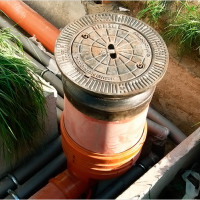 How to make a drainage well with your own hands and bring pipes to it
How to make a drainage well with your own hands and bring pipes to it  How much does it cost to connect gas to a private house: the price of organizing gas supply
How much does it cost to connect gas to a private house: the price of organizing gas supply  The best washing machines with dryer: model rating and customer tips
The best washing machines with dryer: model rating and customer tips  What is the color temperature of light and the nuances of choosing the temperature of the lamps to suit your needs
What is the color temperature of light and the nuances of choosing the temperature of the lamps to suit your needs  Replacement of a geyser in an apartment: replacement paperwork + basic norms and requirements
Replacement of a geyser in an apartment: replacement paperwork + basic norms and requirements